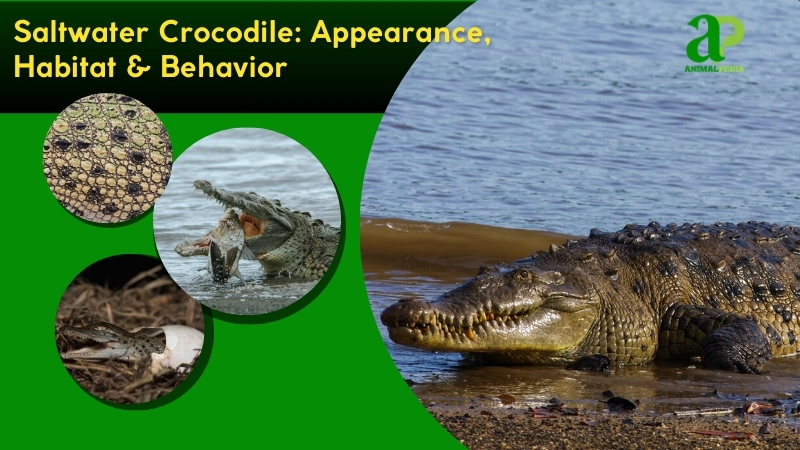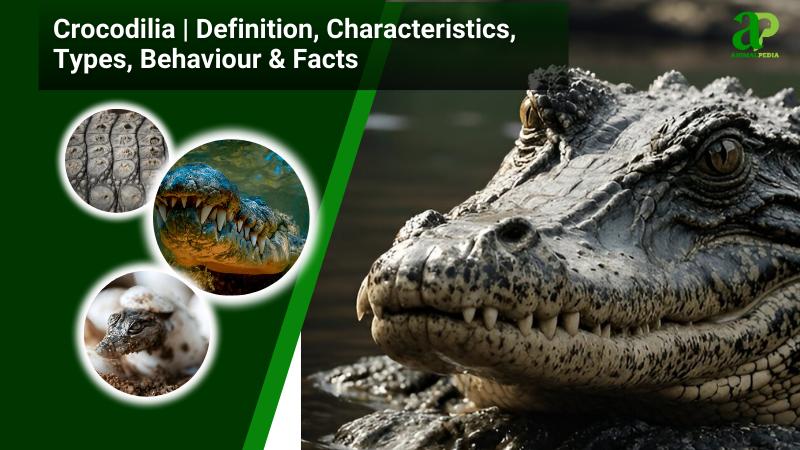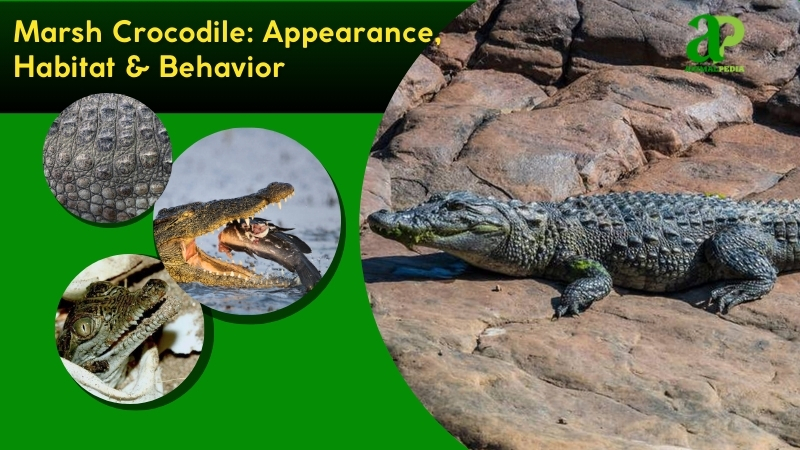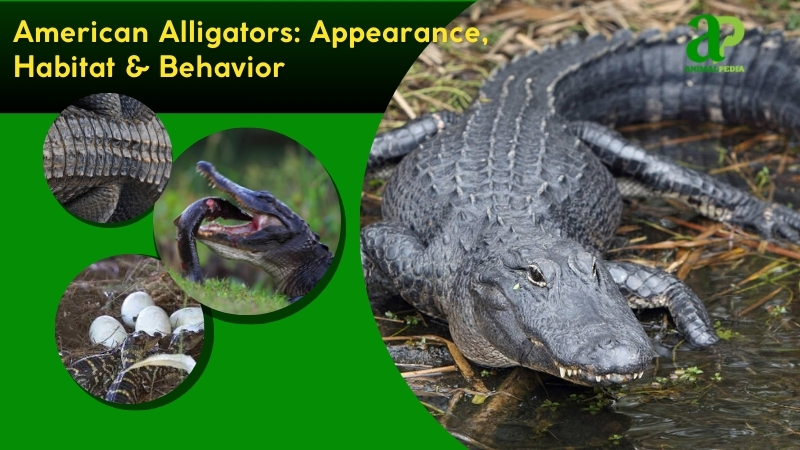Nile crocodiles captivate with their prehistoric allure. Only one species exists: Crocodylus niloticus. These massive reptiles dominate rivers across sub-Saharan Africa and Madagascar. Males reach up to 18 feet (5.5 meters) and weigh 1,650 pounds (750 kilograms). Armored scales and powerful jaws define their appearance, proving their evolutionary success.
Their olive-green to grayish-brown hide blends with murky waters. The name Crocodylus niloticus reflects its Nile River origins, though it thrives from Senegal to South Africa. Distinctive features include a broad snout and interlocking teeth visible when jaws close. Adults stretch 4-5.5 meters, with tails enabling swift aquatic strikes.
Habitats span freshwater ecosystems—rivers, swamps, and estuaries—across 26 African countries and Madagascar’s western wetlands. They prefer warm, shallow waters rich with prey. Their range includes the Congo Basin, Lake Victoria, and the Senegal River. Adaptability to seasonal floods and droughts demonstrates their resilience as keystone species in ecosystems.
As apex predators, Nile crocodiles ambush with precision. They hunt fish, antelope, zebras, and sometimes humans, using the death roll to overpower prey. Their diet changes with availability, indicating opportunistic feeding. Territorial males roar and slap water to assert dominance. Human encounters prove deadly near settlements—over 300 attacks annually, according to the 2020 CrocBITE database records.
Mating peaks during dry seasons, August to September. Females lay 25-80 eggs in sandy nests, guarding them for 80-90 days. Hatchlings emerge vulnerable at 30 centimeters. Juveniles grow rapidly, reaching sexual maturity at 10-12 years. Lifespan ranges from 70 to 100 years under optimal conditions.
This article explores the Nile crocodile’s biology, ecology, and predatory behavior—revealing Africa’s dominant aquatic predator in strength, strategy, and survival expertise.
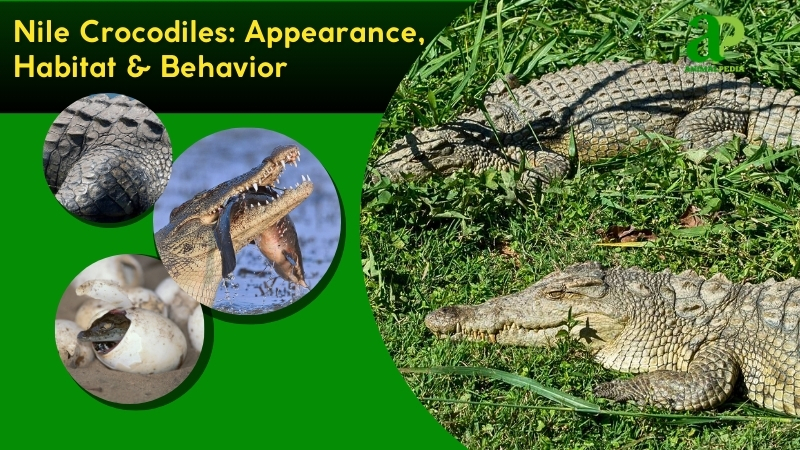
What do the Nile crocodiles look like?
Nile crocodiles have robust, elongated bodies. Their color ranges from olive-green to grayish-brown, with darker crossbands that fade with age—ideal camouflage in murky waters. Their tough, keratinized skin features bony plates called osteoderms, creating an armored exterior. These thick, overlapping scales protect them throughout sub-Saharan Africa’s rivers and Madagascar’s wetlands.
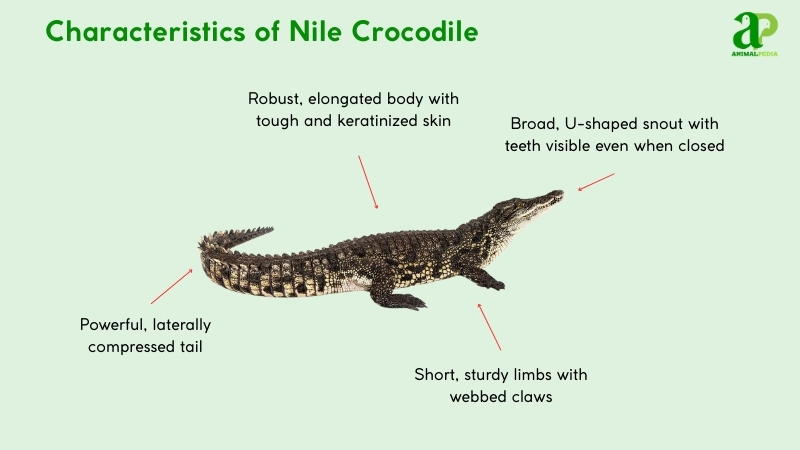
Their broad, U-shaped snout contains conical teeth visible even when the mouth is closed—a distinctive identifier. Yellowish-green eyes sit high on the head, affording a panoramic view. A powerful neck supports their massive head, while their body transitions into four short, strong limbs with webbed claws for swimming.
Their powerful tail, often half their total length, propels them at speeds up to 35 km/h in water. Unlike alligators, their fourth tooth protrudes when the mouth is closed, and their snout is narrower than that of the Saltwater crocodile (Crocodylus porosus). These anatomical features distinguish them from other crocodilian species.
How big do Nile crocodiles get?
Nile crocodiles’ average length and weight are 14 feet (4.2 meters) and 900 pounds (410 kilograms) for males, while females reach 10 feet (3 meters) and 500 pounds (225 kilograms). These measurements reflect their dominance in African waterways. Adults typically span 13-18 feet (4-5.5 meters) from snout to tail, with males out-sizing females consistently across their range.
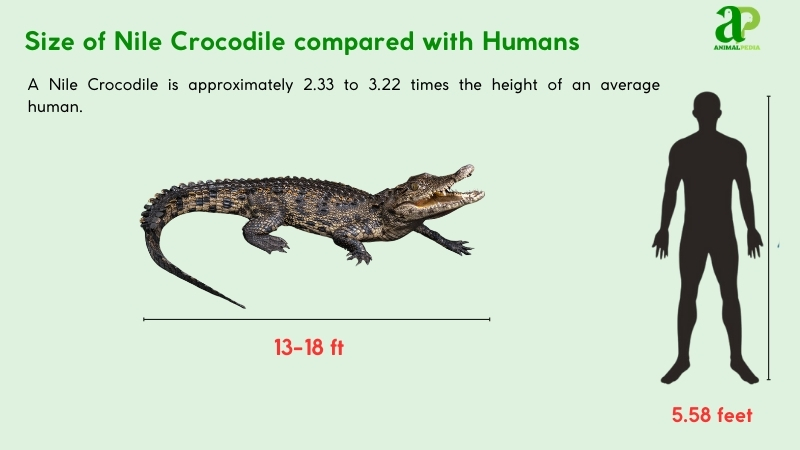
The largest recorded Nile crocodile specimen measured 21 feet (6.45 meters) and weighed 2,400 pounds (1,090 kilograms), found in Tanzania’s Rufiji River, as documented by Hartley (2018).
Males dwarf females by 3-6 feet (1-2 meters) and nearly double their weight, reflecting sexual dimorphism tied to territorial roles. See the table below for key differences.
| Trait | Male | Female |
| Length | 13-18 ft (4-5.5 m) | 8-10 ft (2.5-3 m) |
| Weight | 900-1650 lb (410-750 kg) | 500-660 lb (225-300 kg) |
What are the unique physical characteristics of the Nile Crocodiles?
Nile crocodiles have distinct physical traits that separate them from other crocodilians. Their fourth mandibular tooth is visible when the mouth closes—a feature alligators lack. This dental characteristic, combined with their broad U-shaped snout, allows for immediate identification. Their scales contain sensory integumentary organs that detect changes in water pressure, making them perfect for ambush hunting. These adaptations have evolved across their range in sub-Saharan Africa and Madagascar.
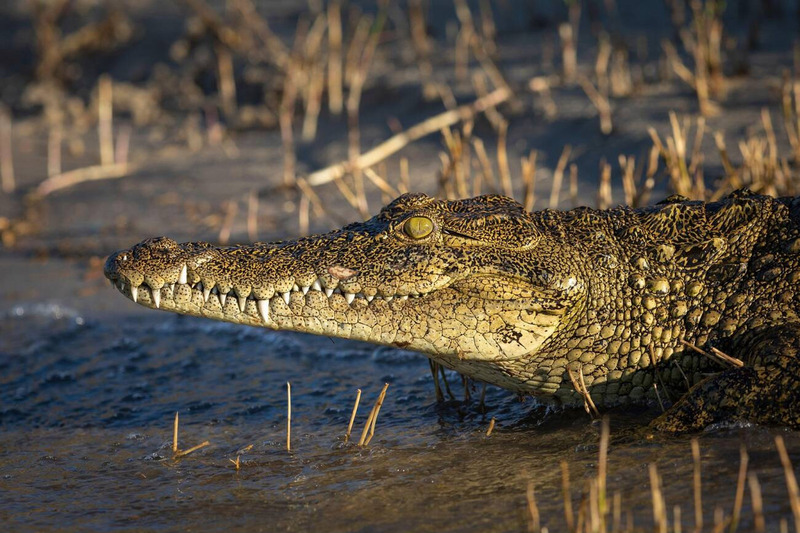
Research by Hekkala et al. (2021) shows their osteoderms—the bony plates in their skin—are denser and harder than those of similar species. This provides superior armor and temperature regulation. Their snout width allows effective prey crushing, unlike the fish-specialized narrow jaws of the Mecistops cataphractus (slender-snouted crocodile). Their laterally compressed tails generate a powerful swimming force, producing bursts of 35 km/h (22 mph)—an exceptional speed for aquatic reptiles. These evolutionary refinements establish them as apex predators in their ecosystem.
How do Nile crocodiles sense their environment with its unique features?
Nile crocodiles detect their world through specialized sensory organs embedded in their scales. These distinctive pits detect water-pressure changes, helping them locate prey in murky African waterways. Their ambush strategy depends on this precision, perfected through evolutionary adaptation.
Their elevated eyes provide wide-angle vision while barely breaking the water’s surface. Acute hearing detects low-frequency sound waves, revealing distant movements. A sophisticated olfactory system identifies chemical signatures in water, directing them to food sources. Pressure-sensitive receptors in their jaws feel prey struggles, improving hunting success. These combined sensory adaptations create the perfect apex predator, precisely attuned to its riverine habitat.
Anatomy
Nile crocodiles are evolutionary marvels, with anatomy finely tuned for survival in Africa’s rivers, lakes, and wetlands. Their internal systems reveal a design built for power, endurance, and precision—hallmarks of a successful apex predator.
- Respiratory System: Lungs with a unidirectional airflow enhance oxygen intake. The muscular diaphragm aids submerged breathing, a vital skill for ambushing prey in African rivers.
- The circulatory system: A four-chambered heart efficiently separates oxygenated blood. Valves shunt blood during dives, supporting prolonged submersion.
- Digestive System: Powerful jaws and a gizzard-like stomach grind bones to a pulp. Acidic digestion enables diverse prey, from fish to zebras, to fill their apex role.
- Excretory System: Kidneys filter waste with minimal water loss. Salt glands located near the tongue excrete excess salts, allowing animals to adapt to brackish wetlands.
- Nervous System: A keen brain integrates sensory pits and eyes. Rapid reflexes drive predatory strikes, honed for survival in dynamic ecosystems.
Together, these anatomical systems form a robust biological framework that enables the Nile crocodile to dominate its environment. From respiration to predation, every organ system contributes to a legacy of evolutionary success.
Where do Nile crocodiles live?
Nile crocodiles inhabit vast regions across sub-Saharan Africa and the western portions of Madagascar. These apex predators concentrate primarily in four major water systems: the Nile River basin, the Congo Basin, the Lake Victoria region, and the Senegal River ecosystem. Notable population centers include Tanzania’s prey-rich Rufiji River and Uganda’s Murchison Falls, where aquatic resources support substantial crocodile communities.
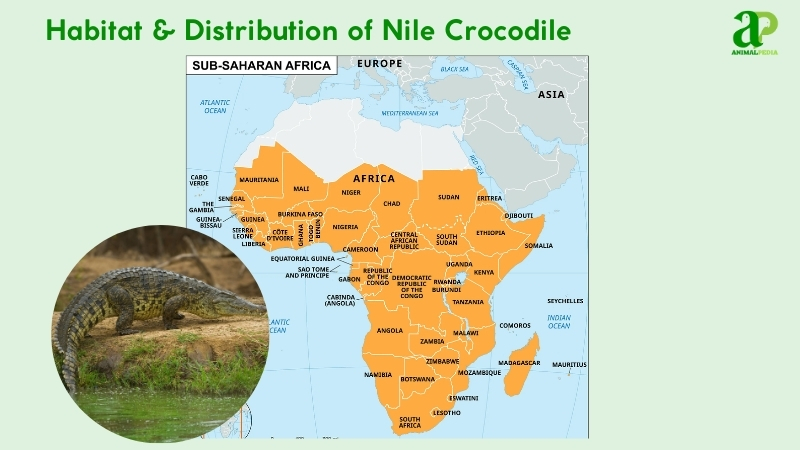
Their preferred habitats encompass rivers, lakes, marshlands, and brackish estuaries, characterized by warm, shallow waters that are essential for effective thermoregulation and hunting success. The riparian environments with dense vegetation and muddy banks perfectly accommodate their ambush predation strategy.
Paleontological evidence suggests that these reptiles have occupied these territories for over 7 million years without any significant range shifts. Research by Leslie et al. (2017) demonstrates a strong correlation between Nile crocodile distribution and stable wetland ecosystems that satisfy their specialized predatory requirements and reproductive needs.
The Nile crocodile is a powerful predator, but the Cuban crocodile offers its own unique traits, such as its smaller size and aggressive behavior. To learn more about this fascinating species, explore the Cuban crocodile and its distinct characteristics.
How do seasonal changes affect their behavior?
Nile crocodiles adjust their behavior in response to seasonal shifts, enabling them to thrive in Africa’s dynamic ecosystems. Changes in rainfall and river levels shape their hunting, breeding, and survival strategies year-round.
- Dry Season: From May to October, they bask on riverbanks to conserve energy. Mating peaks in August, with males roaring to claim territory.
- Wet Season: November to April brings hunting surges. Flooded rivers boost prey availability, triggering aggressive ambushes. Females guard nests fiercely.
By aligning their habits with seasonal cycles, Nile crocodiles maximize reproductive success and maintain their role as apex predators in fluctuating habitats.
What is the behavior of Nile crocodiles?
Nile crocodiles are among the most formidable predators in Africa, displaying a wide range of sophisticated behaviors that reflect their evolutionary success. From their powerful bites to complex social dynamics, these reptiles are finely tuned to dominate their aquatic and terrestrial habitats.
- Feeding Habits: They ambush prey with explosive lunges, eating fish, antelope, and occasionally humans. Diets adapt to prey availability.
- Bite & Venomous: Nile crocodile bite force, crushing at 5,000 psi, lacks venom. Jaws lock onto prey with unrelenting force.
- Daily Routines: They bask by day, hunting at dusk or night. Activity peaks in warmer months.
- Locomotion: Powerful tails propel them at 35 km/h (22 mph) in water. On land, they crawl or gallop briefly.
- Social Structures: Males dominate territories; females guard nests. Solitary outside the mating season.
- Communication: Low roars and the sound of water slapping signal dominance. Hatchlings chirp to mothers.
These behaviors not only secure their place at the top of the food chain but also reveal a creature shaped by millions of years of adaptation. Their feeding strategy, in particular, exemplifies both efficiency and raw power.
What do Nile crocodiles eat?
Nile crocodiles are apex carnivores, consuming a wide range of prey depending on size, age, and habitat. Their menu features a diverse range of options, including fish, birds, mammals, and even other reptiles.
Their ambush strategy is brutal—lying submerged before lunging, clamping jaws that crush at 5,000 psi, and executing the signature “death roll” to dismember large prey. They may stash kills underwater to soften before eating. While attacks on humans are rare, they occur most often near rivers and during nesting season (Wallace et al., 2019).
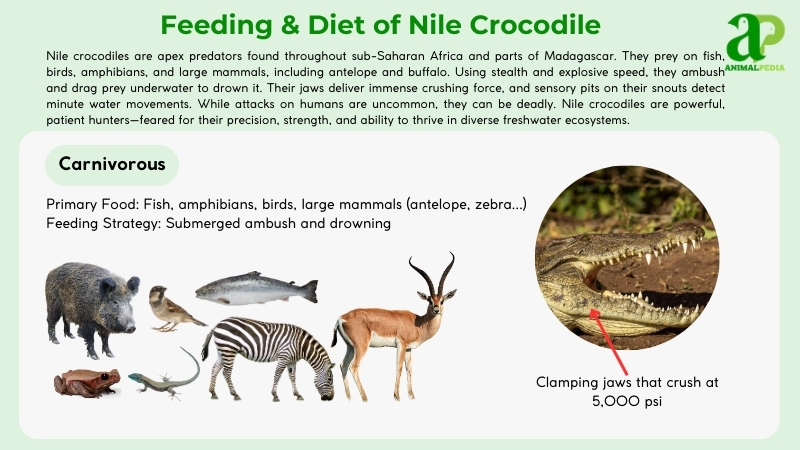
- Diet by Age
Nile crocodile diets change with development. Hatchlings eat aquatic insects, small frogs, and tiny fish—food they can catch and swallow whole. Juveniles expand to larger fish, crabs, and small birds. Adults, with greater strength and jaw power, consume large mammals such as wildebeest, antelope, and livestock. Cannibalism of smaller crocodiles may also occur.
- Diet by Gender
Male and female Nile crocodiles share similar diets, both targeting large prey as adults. However, adult males—being larger—may dominate high-value prey or prime hunting spots. Females may focus on smaller animals when nesting, conserving energy and staying near nest sites. Juveniles of both sexes consume small, manageable prey until they are physically capable of tackling larger targets.
- Diet by Seasons
During the dry season (May to October), prey congregates at shrinking water bodies, providing easy hunting opportunities for fish and thirsty herbivores. Nile crocodiles capitalize on increased ambush success. During the wet season (November to April), dispersing prey and flooded areas reduce visibility and density. They shift to hunting more aquatic animals and opportunistic catches, such as birds or amphibians.
How do Nile crocodiles hunt their prey?
Nile crocodiles are skilled hunters, patiently waiting beneath the water’s surface for the perfect moment to strike. With their eyes and nostrils positioned on top of their heads, they can hidden from view, ready to ambush unsuspecting prey that come too close to the water.
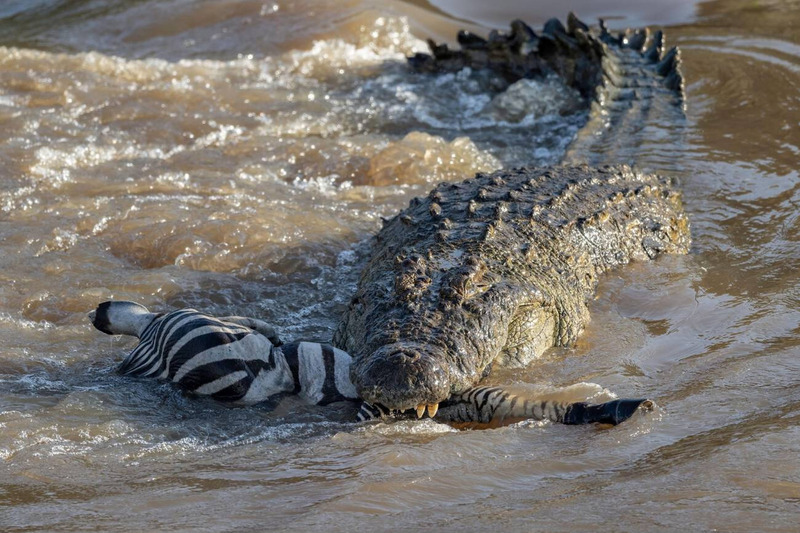
When an opportunity arises, these predators launch a lightning-fast attack, using their powerful jaws to seize their target.
These crocodiles are known for their strategic hunting tactics, conserving energy until the right moment presents itself. Once they capture their prey, Nile crocodiles rely on their strength to drag it underwater and drown it, making the meal easier to consume.
Combining patience, precision, and power, Nile crocodiles are formidable hunters in their aquatic environment.
Are Nile crocodiles venomous?
Unlike some snakes, Nile crocodiles aren’t venomous; they rely on their powerful jaws to capture and overpower prey underwater. They are known for their exceptional hunting skills, making them formidable predators in their natural habitat.
These crocodiles exhibit impressive hunting techniques, utilizing stealth and incredible speed to ambush unsuspecting animals approaching the water’s edge. With lightning-fast reflexes, they launch themselves out of the water to grasp their victim with sheer force.
The intense pressure from their bite can immobilize or fatally injure their prey, showcasing their efficiency as top predators in their ecosystem. The hunting behavior of Nile crocodiles highlights the raw power of nature.
When are Nile crocodiles most active during the day?
Nile crocodiles are most active during the night, early morning, and late evening. These reptiles take advantage of the darkness to hunt prey and regulate their body temperature effectively. During the scorching heat of the day, Nile crocodiles tend to rest near water to stay cool and conserve energy.
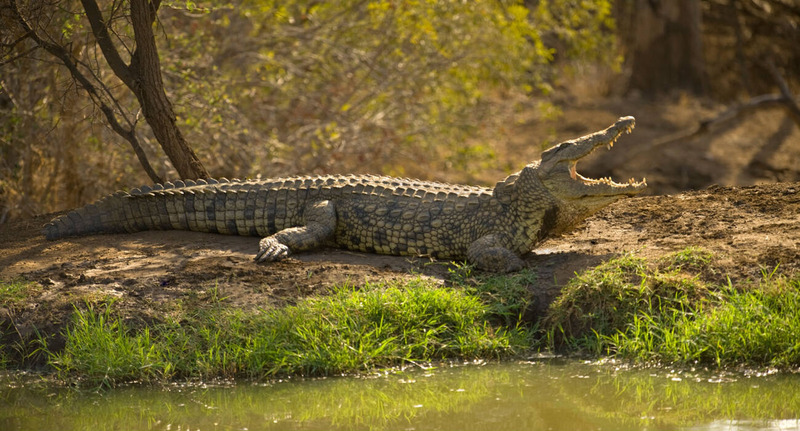
If you want to spot these creatures, your best bet is to look for them during the twilight hours when they’re most active and alert. It’s fascinating to witness how these impressive predators adapt to their environment to thrive and survive.
Keep in mind that Nile crocodiles play a crucial role in their ecosystem as top predators, maintaining the balance of their habitat. So, observing their behavior can offer valuable insights into the intricate web of life in the wild.
How do Nile crocodiles move on land and water?
Nile crocodiles move with stunning efficiency in both water and land environments. In water, they propel themselves using their powerful muscular tails as a primary locomotor organ. Their streamlined bodies cut through water with minimal resistance, allowing them to reach speeds up to 35 km/h during short bursts.
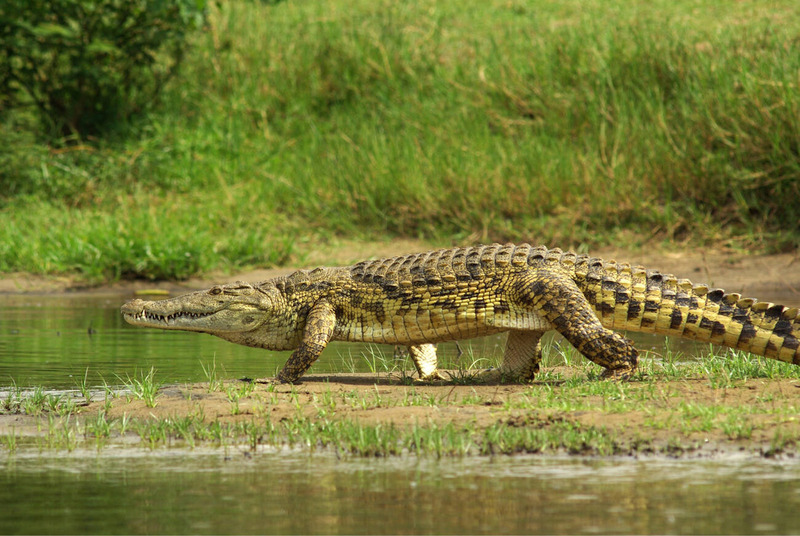
On land, these reptiles employ two distinct gaits. During the high walk, they lift their bodies off the ground, holding their legs almost vertically. When speed is essential, they switch to a belly run or gallop, reaching surprising speeds of 12-14 km/h over short distances. This movement involves the simultaneous use of diagonal limbs, creating an alternating stride pattern.
Their anatomical adaptations serve dual locomotion needs perfectly. Webbed feet provide aquatic propulsion while still functioning effectively on land. The laterally compressed tail works as both a swimming rudder and a counterbalance during terrestrial movement. Nile crocodiles demonstrate biomechanical efficiency by seamlessly transitioning between these environments, conserving energy through their specialized locomotion strategies.
Do Nile crocodiles live alone or in groups?
Nile crocodiles are known for preferring a solitary lifestyle rather than living in groups. These impressive reptiles navigate the waters and shorelines of Africa with independence and dominance. They establish their territory in the murky waters of the Nile River, showcasing their strength and self-reliance.
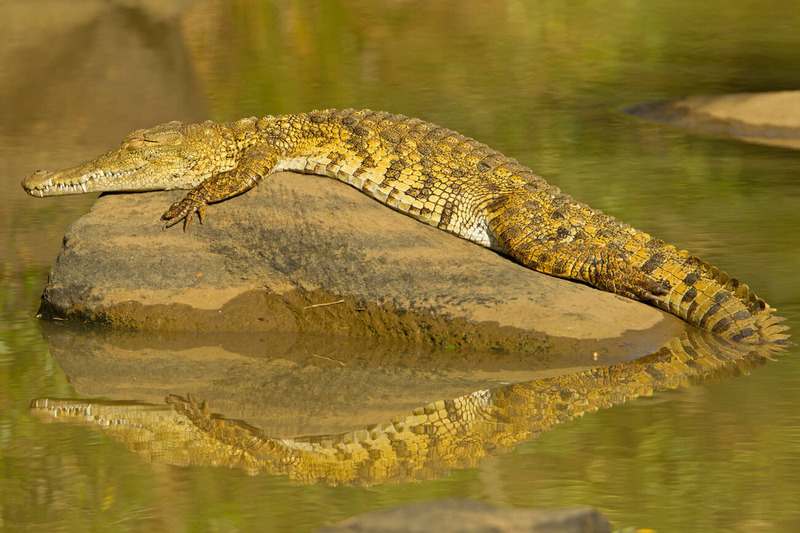
By choosing to live solo, Nile crocodiles can roam freely, hunt stealthily, and bask in the sun undisturbed. Their solitary nature allows them to thrive in their own pursuits, highlighting the power of individuality in the animal kingdom.
Next time you picture Nile crocodiles in their habitat, remember that these creatures excel at navigating their world on their own, underscoring the beauty of independence in nature.
How do Nile crocodiles communicate with each other?
Nile crocodiles use three main communication channels to interact with their peers. Vocalizations serve as primary auditory signals—including deep bellows, sharp hisses, and low-frequency grunts—to mark territory boundaries, attract potential mates during breeding season, and alert others to danger.
Body language constitutes their visual signaling system. Dominant crocodiles display open-mouth posturing (jaw gaping), specific head positioning, and calculated tail sweeps to convey intentions and establish hierarchy within social structures. Subordinate individuals respond with distinct submission gestures to maintain group order.
Chemical communication forms their third signaling method. These reptiles release pheromones through specialized glands, creating chemical signatures that transmit critical information about reproductive status and territorial claims. This multimodal communication system—acoustic, visual, and chemical—enables Nile crocodiles to maintain complex social dynamics in both aquatic and terrestrial environments across their African range.
How do Nile crocodiles reproduce?
Nile crocodiles reproduce sexually. Breeding begins in the dry season, between August and September. Males attract mates by bellowing and slapping the water. Females signal interest through subtle head movements. Mating occurs in water—quick but intense.
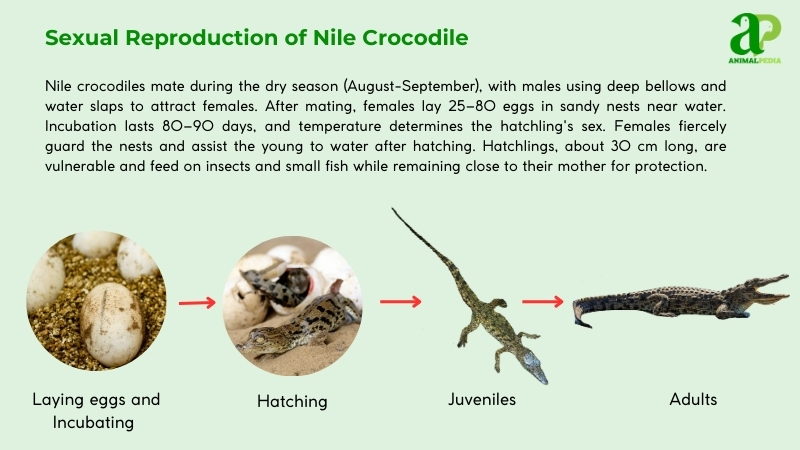
After mating, females dig nests in sandy riverbanks and deposit 25-80 eggs. Each egg weighs about 70 grams. Males depart after copulation, while females guard the nest vigilantly—providing shade and protection from predators. Environmental stability directly affects reproductive success, and natural disasters like the 2019 Tanzania floods can destroy entire clutches.
Eggs incubate for 80-90 days. Mothers respond to pre-hatching vocalizations, assisting their offspring’s emergence. Hatchlings measure approximately 30 cm and face extreme mortality—only 2% reach adulthood. They grow roughly 30 cm yearly and achieve sexual maturity at 10-12 years of age. This reproductive strategy—combining low juvenile survival with longevity and high reproductive output—maintains their ecological position as apex predators in African freshwater ecosystems.
How long do Nile crocodiles live?
Nile crocodiles exhibit one of the longest lifespans among reptiles, averaging 70–100 years in the wild, though some may exceed this range in captivity. Their life cycle includes a prolonged juvenile phase, with individuals reaching sexual maturity between 10 to 12 years.
While males tend to grow larger and dominate territories, current studies show no significant difference in lifespan between sexes. Nile crocodile lifespan is influenced by environmental stability, prey availability, and human pressures. Despite high juvenile mortality—only 1–2% survive to adulthood—those that reach maturity become long-lived apex predators.
What are the threats or predators that Nile crocodiles face today?
Nile crocodiles are apex predators, yet they face growing threats driven by human activity and environmental change.
- Habitat Loss: Wetland drainage for agriculture and infrastructure has reduced their natural range by over 30% since 2000. Shrinking freshwater ecosystems increase population stress and fragmentation.
- Poaching: Illegal hunting for skin and meat continues to decimate populations. These activities often target mature individuals, disrupting breeding cycles and resulting in estimated annual losses of 15%.
- Climate Change: Rising temperatures, altered rainfall patterns, and frequent floods reshape their nesting grounds. Extended droughts reduce prey availability, intensifying human-wildlife conflict near water sources.
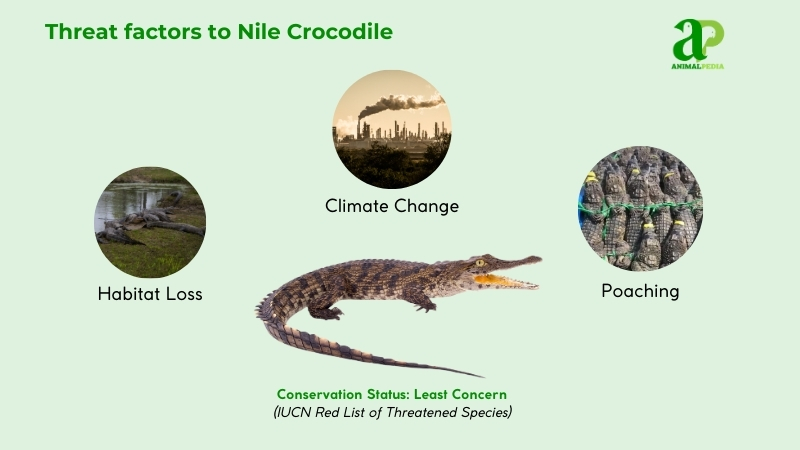
Human impact is the most significant threat. Overfishing depletes prey stocks, and retaliatory killings often follow crocodile attacks. Over 300 such incidents are reported annually. Research indicates that up to 40% of declines in the Nile crocodile population in some regions are directly linked to human activity.
Despite their dominance in the wild, Nile crocodiles are increasingly at risk due to compounded anthropogenic pressures. Conservation efforts must prioritize habitat protection, sustainable fishing practices, and human-crocodile coexistence strategies to ensure the survival of these species.
Are Nile crocodiles endangered?
Nile crocodiles are not endangered. The International Union for Conservation of Nature (IUCN) lists them as Least Concern on their Red List. These reptiles face no immediate risk of extinction across their range.
These apex predators thrive across sub-Saharan Africa and Madagascar. Their ability to adapt to rivers, lakes, and wetlands supports their stable conservation status. Current wild population estimates range from 250,000 to 500,000 adult specimens.
Field research shows impressive numbers. Tanzania’s Rufiji River maintains 50-70 crocodiles per kilometer, while Uganda’s Nile River reports similar densities. These figures confirm their robust presence throughout their natural habitat (IUCN, 2016).
Despite overall stability, Nile crocodiles face regional challenges. Poaching for leather, habitat loss, and human-wildlife conflict threaten local populations. Protected areas, such as Kruger National Park and the Okavango Delta, provide crucial sanctuaries for these ancient reptiles.
Conservation programs monitor population trends and mitigate threats to these populations. Sustainable management practices help balance crocodile preservation with human safety concerns in populated areas. Unlike their cousins, the critically endangered Philippine and Siamese crocodiles, Nile crocodiles maintain healthy numbers across their range.
What conservation efforts are underway?
Several conservation efforts have been implemented to protect Nile crocodiles across their range. Key organizations, such as The Crocodile Specialist Group (CSG) and Wildlife Conservation Society (WCS), are actively involved in monitoring and safeguarding these apex predators. These efforts have been especially important since the 1980s, when hunting and habitat destruction led to significant population declines.
Laws across various African countries have been enacted to prevent the hunting and trade of Nile crocodiles. For instance, CITES (Convention on International Trade in Endangered Species of Wild Fauna and Flora) has placed Nile crocodiles under Appendix II, which regulates international trade to ensure it does not threaten the species’ survival. National laws, including protected area designations in countries such as Tanzania and Uganda, prohibit poaching and disturbance of crocodile habitats.
Breeding programs have also played a critical role in Nile crocodile conservation. In South Africa, the Kruger National Park and other reserves have successfully implemented breeding programs that have stabilized crocodile populations. In these controlled environments, conservationists have increased hatchling survival rates through careful monitoring and predator protection. These programs also help restore populations in areas where crocodiles were once driven to local extinction.
In Uganda, the Lake Kyoga Crocodile Reintroduction Project has been particularly successful, with crocodiles once endangered now re-establishing sustainable populations. Success rates from these initiatives have increased hatchling survival by up to 40% over the last decade, contributing to healthier, more resilient crocodile populations.
Frequently Asked Questions
Are Nile crocodiles cold-blooded?
Yes, Nile crocodiles are cold-blooded, meaning their body temperature depends on the environment. They often bask in the sun to warm up and regulate their body temperature, and they retreat to the water or shade when it’s too hot.
Are Nile crocodiles dangerous to humans?
Yes, Nile crocodiles are dangerous to humans. They are large, powerful, and territorial. Crocodile attacks can occur when people accidentally enter their territory, especially near water sources where they hunt.
Do Nile crocodiles care for their babies?
Yes, female Nile crocodiles protect their nests and help their hatchlings after they are born. When the babies emerge from their eggs, the mother carries them to the water, ensuring their safety from predators.
How fast can a Nile crocodile move?
Nile crocodiles are surprisingly fast. On land, they can run at up to 10-12 km/h (6-7 mph) in short bursts, while in the water they swim much faster, reaching 20-25 km/h (12-16 mph) when chasing prey.
How do Nile crocodiles breathe underwater?
Nile crocodiles can hold their breath for long periods. They often stay submerged for up to 30 minutes, though they can hold their breath for several hours when necessary. They do this by slowing their heart rate and conserving oxygen.
Conclusion
Nile crocodiles rank among nature’s most formidable predators. Their massive size, bone-crushing jaws delivering 5,000 psi bite force, and sophisticated hunting tactics establish them as apex predators throughout their range. These ancient reptiles dominate riverine ecosystems across sub-Saharan Africa, from the Nile basin to the Okavango Delta.
Their sensory adaptations—pressure-sensitive organs, night vision, and underwater hearing—make them perfectly evolved killing machines. Crocodiles employ ambush strategies with deadly efficiency, demonstrating complex behavioral intelligence that has persisted since the Mesozoic era.
When observing these megafauna in their natural habitat, maintain a respectful distance. Their continued existence represents the biodiversity worth preserving within Africa’s threatened wetland ecosystems. The Nile crocodile embodies nature’s raw power and evolutionary success—a living dinosaur still thriving in our modern world.





